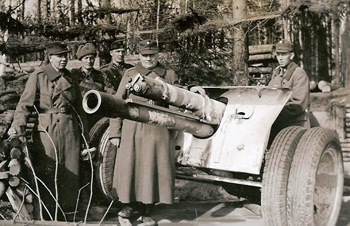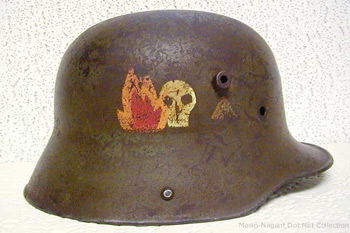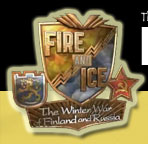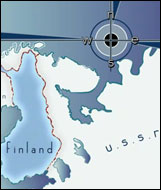

Nearing the End of the Continuation War
While the Battle of Tali Ihantala was the turning point of the war it was not the only battle that was underway. On July 4, the Soviets moved into the Bay of Vyborg area and took the islands of Ravansaari and Suonionsaari. The Soviets hoped that by taking these islands they could regroup and still possibly make a move into Finland. But, their hopes were dashed when Finnish and German (the German 122nd Division) troops ended the Soviet advance on July 7 and 8.
There was also action at Battle of Vuosalmi. The main sections of this battle took place July 4-1, with the Soviets attempting to break the Finnish defenders of this sector and encircle the Finnish troops further south on the Karelian Isthmus. The Soviets seemed to take the advantage early in the fighting but the Finns were able to turn the tables and destroy the attacking Red Army force.
 Finnish
artillery in 1944.
Finnish
artillery in 1944.
Brent Snodgrass
The End – Battles In Eastern Karelia
There had been battles raging on the other side of Lake Ladoga
since June 21 with the Finns mainly engaged in delaying tactics
against
the advancing Soviet forces. The Finns knew the battles on the
Isthmus carried more importance, so it was not until after Tali
Ihantala
that the Finns could give the proper attention to this front. There
were many smaller battles in this region, but the main focus of
the region at the end of July was the area around Ilomantsi.
After three weeks of fighting delaying tactics the Finns were able
to bring in more soldiers to assist on this front. The Finnish
Cavalry Brigade entered the area after being released from the
Karelian Isthmus.
The terrain on this front includes many forests, lakes and swamps. There were few roads or rail lines in the region. These factors made the moving heavy equipment quite difficult for both the Finns and the Soviets. After Finnish reconnaissance units had been able to pin point the Soviet positions, which was no easy task in the woods, a Finnish attack plan was drawn out. The Finnish high command had ordered that the Soviets in the area be stopped and removed as a threat to the Finnish nation. The plan was to launch a two-sided attack that would encircle the Soviet troops and split them into two groups. The Finns would then destroy these forces and push the remaining Red Army troops back across the old 1939 border. The battles here lasted for 10 days and the Finns were able to meet their goal of breaking up the Soviet forces. Even in the rough terrain Finnish artillery was able to fire over 36,000 rounds during this battle and played a key role in the Finnish victory. The battles in the Ilomantsi region were the last of the Continuation War.
 Helmet
issued to Tauno Johannes Kirsi who was a member of the mounted artillery
in the battle of Ilomantsi.
Helmet
issued to Tauno Johannes Kirsi who was a member of the mounted artillery
in the battle of Ilomantsi.
Brent Snodgrass collection
The Peace
After the Finnish efforts from June to August, the Soviets made
the decision that continuing the war against Finland would be much
more
costly than they had imagined. While the Red Army was still strong
the Soviets knew its efforts had to be focused on the defeat of Germany.
The time and effort needed to fight the Finns would outweigh the
gains.
By August 4, Finnish President Risto Ryti had resigned and Marshal Mannerheim was appointed President of Finland. This change helped lead the way for peace as Stalin and the Soviet leadership did not trust Ryti but felt that Mannerheim was a man they could create peace terms with. Mannerheim had long been a supporter of making a separate peace with the Soviet Union and began to make overtures to the Soviets. Hitler and the Germans were unsure of the Finnish plans. In an effort to show support towards Mannerheim, Hitler presented him with the Oak Leaf of the Knight's Cross of the Iron Cross. This gesture did not alter Mannerheim’s wishes for peace. On September 1, he sent a letter to Stalin urging the ending of the war based on the negotiations which had been ongoing. On September 2, the Finnish Eduskunta, or Parliament, accepted the terms of the armistice and ended all relations with Germany. It also stated that all German troops must leave Finland by the September15, or be subject to attack. On September 4, Stalin accepted the Finnish terms, although Soviet artillery fired just until the set time of cease fire ending the war.
The preliminary peace agreement signed in September 1944 was quite harsh to Finland: The borders from 1940 were reestablished and the Petsamo area was lost; Finland was forced to expel any German troops inside Finnish borders after September 15; the Porkkal Peninsula was leased to the Soviets for 50 years and full transit rights to the Peninsula were granted; the Civil Guard as well as the Lotta Svärd and various other patriotic groups were banished; the Finnish Communist Party was given legal status; the size of the Finnish military was restricted; and finally, Finland was forced to pay massive war reparations to the Soviet Union.
While these terms were hard to live with, the Finns were secure in the fact that they had remained free and were not occupied by the Soviet Union. Finland is the only nation to fight against the Soviet Union during World War II not to be occupied in war time or during the post war years. This accomplishment bears witness to the heroic actions of the Finnish military in the Continuation War, during which more than 60,000 Finnish soldiers were lost.





